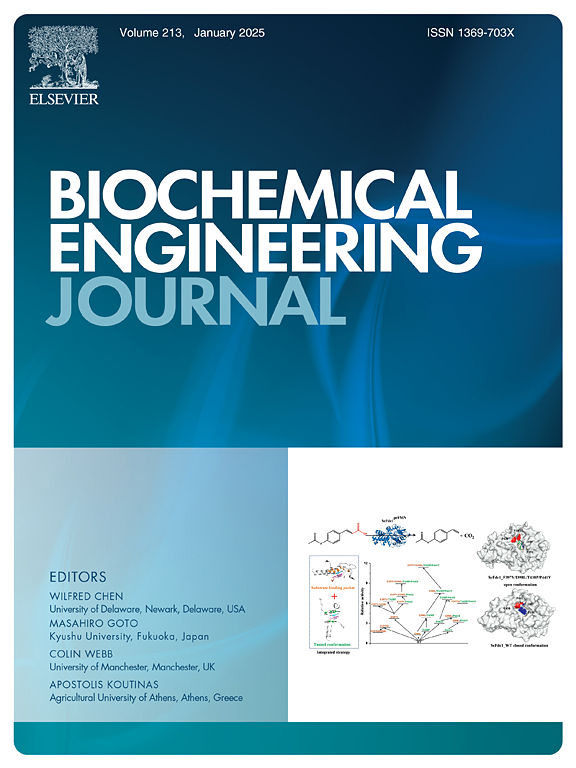Spatiotemporal dynamics of algal-microbial interactions in a membrane photobioreactor for integrated nutrient remediation and microalgal resource recovery from shrimp aquaculture wastewater
IF 3.7
3区 生物学
Q2 BIOTECHNOLOGY & APPLIED MICROBIOLOGY
引用次数: 0
Abstract
The projected rise of global aquaculture to 106 million tons by 2030 has amplified concerns over nutrient-rich wastewater, demanding sustainable treatment solutions. This study developed an aerated membrane photobioreactor (MPBR) to simultaneously assess nutrient removal, biomass productivity, and algal–microbial community dynamics. High-throughput sequencing identified a dominant, stable consortium featuring the nitrogen-fixing Azospirillum (20.81 %) and the eukaryotic alga Halochlorella (53.19 %). Membrane surface analysis revealed a diverse biofilm community including Limnothrix (12.36 %) and Scenedesmus (28.70 %), suggesting synergistic microbial interactions. Isolated dominant species achieved total nitrogen (TN) removal of 58.36 %–65.50 %, total phosphate (TP) removal of 97.68 %–100 %, and ammonium (NH₄⁺-N) removal of 97.37 %–100 % at a 10-hour hydraulic retention time. These findings underscore the MPBR's dual functionality in effective nutrient remediation and microalgal biomass valorization, offering an informed strategy for resource recovery and environmentally sustainable aquaculture wastewater management.
膜光生物反应器中藻类与微生物相互作用的时空动态研究——用于对虾养殖废水营养物综合修复和微藻资源回收
预计到2030年,全球水产养殖量将增加到1.06亿吨,这加剧了人们对富含营养的废水的担忧,需要可持续的处理解决方案。本研究开发了一个曝气膜光生物反应器(MPBR),以同时评估营养物去除,生物量生产力和藻类微生物群落动态。高通量测序鉴定出一个稳定的优势菌群,由固氮氮螺旋藻(20.81 %)和真核藻类Halochlorella(53.19 %)组成。膜表面分析显示,不同的生物膜群落包括Limnothrix(12.36 %)和Scenedesmus(28.70 %),表明微生物之间存在协同作用。在10小时的水力停留时间内,分离的优势种总氮(TN)去除率为58.36 % -65.50 %,总磷酸盐(TP)去除率为97.68 % -100 %,铵(NH₄+ -N)去除率为97.37 % -100 %。这些发现强调了MPBR在有效的营养修复和微藻生物量增值方面的双重功能,为资源回收和环境可持续的水产养殖废水管理提供了明智的策略。
本文章由计算机程序翻译,如有差异,请以英文原文为准。
求助全文
约1分钟内获得全文
求助全文
来源期刊

Biochemical Engineering Journal
工程技术-工程:化工
CiteScore
7.10
自引率
5.10%
发文量
380
审稿时长
34 days
期刊介绍:
The Biochemical Engineering Journal aims to promote progress in the crucial chemical engineering aspects of the development of biological processes associated with everything from raw materials preparation to product recovery relevant to industries as diverse as medical/healthcare, industrial biotechnology, and environmental biotechnology.
The Journal welcomes full length original research papers, short communications, and review papers* in the following research fields:
Biocatalysis (enzyme or microbial) and biotransformations, including immobilized biocatalyst preparation and kinetics
Biosensors and Biodevices including biofabrication and novel fuel cell development
Bioseparations including scale-up and protein refolding/renaturation
Environmental Bioengineering including bioconversion, bioremediation, and microbial fuel cells
Bioreactor Systems including characterization, optimization and scale-up
Bioresources and Biorefinery Engineering including biomass conversion, biofuels, bioenergy, and optimization
Industrial Biotechnology including specialty chemicals, platform chemicals and neutraceuticals
Biomaterials and Tissue Engineering including bioartificial organs, cell encapsulation, and controlled release
Cell Culture Engineering (plant, animal or insect cells) including viral vectors, monoclonal antibodies, recombinant proteins, vaccines, and secondary metabolites
Cell Therapies and Stem Cells including pluripotent, mesenchymal and hematopoietic stem cells; immunotherapies; tissue-specific differentiation; and cryopreservation
Metabolic Engineering, Systems and Synthetic Biology including OMICS, bioinformatics, in silico biology, and metabolic flux analysis
Protein Engineering including enzyme engineering and directed evolution.
 求助内容:
求助内容: 应助结果提醒方式:
应助结果提醒方式:


